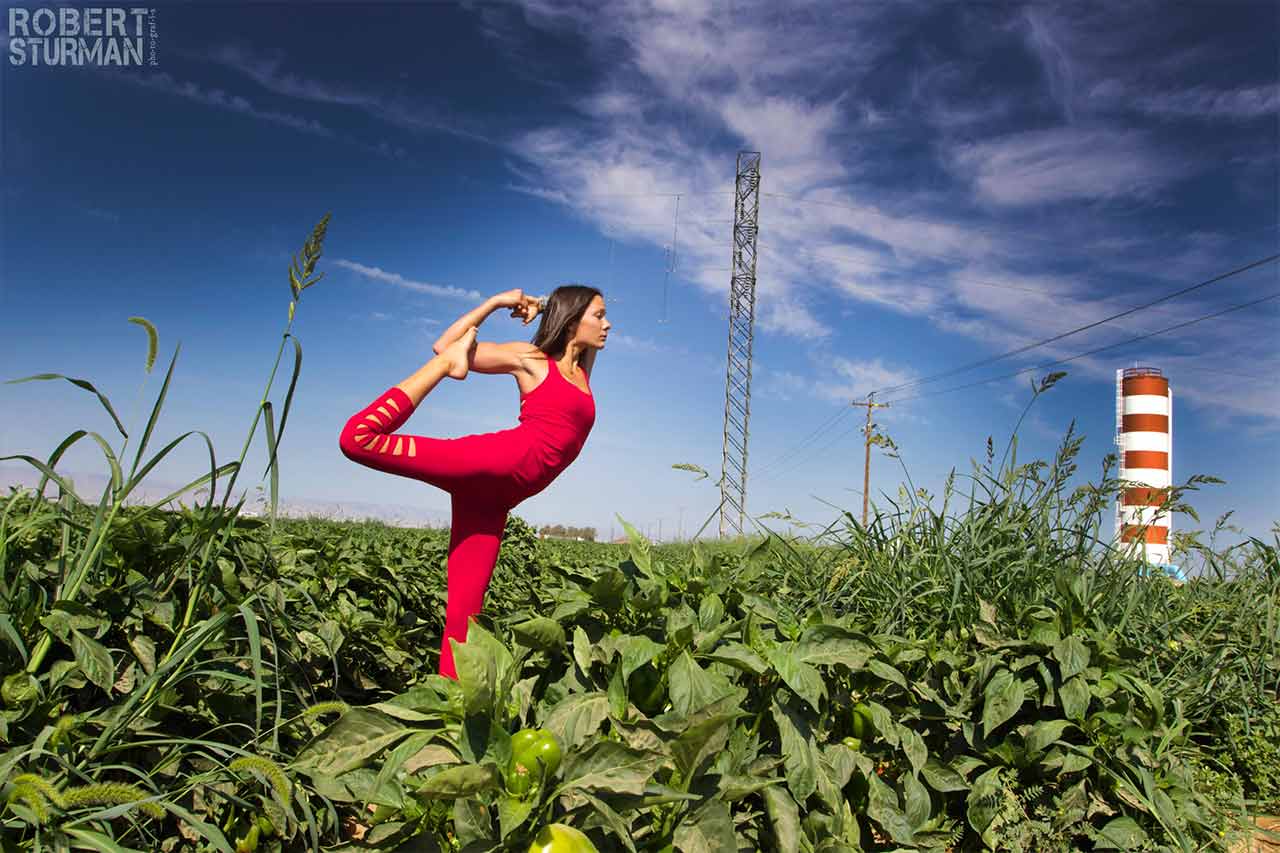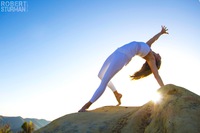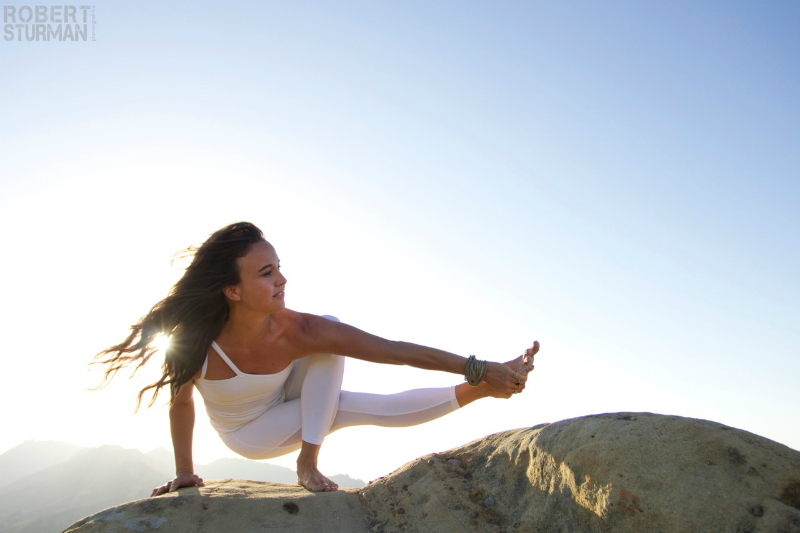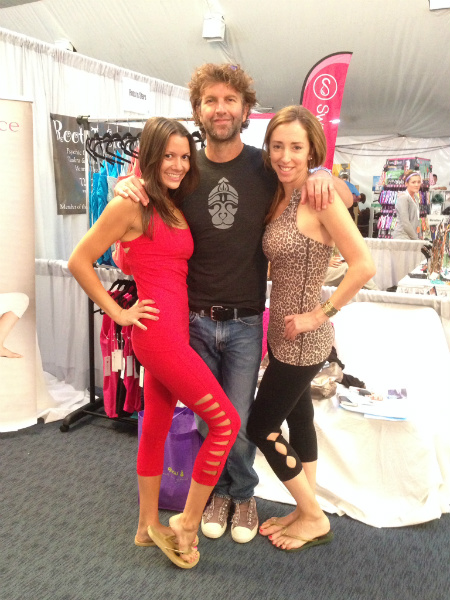
Meet the Artist: Robert Sturman
Shop Summer Warrior

The photographer's role is both one of concealment and exposure. He moves unseen, hidden behind the camera, and yet he shows us the world through his eyes. Artist Robert Sturman invites us to see that life is overflowing with striking beauty. From his work with African orphans practicing yoga in Kenya to his portraits on the streets of Manhattan, his artwork has been recognized and praised worldwide. We had been admirers of his work for a while and were completely taken with the way he perfectly captured so many gorgeous and inspirational yoginis in their element. When we started seeing our very own KiraGrace on his models, we knew a meeting was just waiting to happen. It was clear that the moment had arrived when Robert told us that he would be attending Yoga Journal San Diego. We couldn't wait to meet him! He stopped by the KiraGrace booth to introduce himself, and we were immediately moved by his quiet, down-to-earth nature and his perceptive eyes that didn't miss a thing. It was such a privilege and pleasure to get to spend some time with this brilliant artist and we are excited to present to you our interview with Robert Sturman:
KiraGrace: Your biography states that your passion for photography began when your father gave you your first camera and told you to take pictures of everything you loved. If we look at your work through this standard, it seems apparent that yoga holds a deep place in your heart. What kind of role does yoga play in your life and what inspired you to fall in love with the practice?
Robert Sturman: Yoga is extremely dear to me because I had the desire to create a healthy lifestyle for myself. I am from Los Angeles, so I have been around Yoga for a long time and I knew that it had a reputation as a healing practice, which also integrated meditation. There were not a lot of great role models in the history of art. Many artists before me, including my heroes, had lived lives of desperation and self destruction. I wanted to rewrite that story and learn how to sit in the fire of creativity, and Yoga seemed like the ticket.
In 2000, I was traveling in India and I came across a quote by Osho that would change my life. âTo be creative means to be in love with life. You can be creative only if you love life enough that you want to enhance its beauty, you want to bring a little more music to it, a little more poetry to it, a little more dance to it.â These simple words planted the seed for my Yoga journey and a desire to create from a full, joyous place. It occurred to me that I could have it all.
So, I began practicing Yoga. I learned how to sweat it out, twist it out, balance, breathe and be still. It was a way in which I could be present and sit with life's natural discomforts, rather than run away from them, like we so often do. I think that the greatest gift we can offer ourselves is to learn the practice of going nowhere when life hurts. Life is always going to have discomforts, and if we just sit with it and know it will pass, we sure save a lot of time, money and stress. Yoga is a great investment.

KG: Would you say that the medium of photography is an inherently collaborative project when you use live models? Or is the photographer the âauthorâof these images? Whose story is being told?
RS: In my work, it is a collaboration with unwritten contracts between the models and myself. There is good stuff going on beneath the surface with the connections we are creating. This is the foundation of creative collaboration for me. It is born out of two hearts trusting and being willing to be vulnerable. It also helps that my only focus is to celebrate the individuals I work with. Often times, after I make my first image of/with someone, I show it to them in the camera. At that moment, the 'unwritten contract' of trust is signed and we are on our way to pointing towards the beauty, celebrating the part of ourselves that wants to do and be our best.
KG: What do you think is the responsibility of the artist? How do you personally carry out this conviction in your relationship with your art and subject matter?
RS: There are many responsibilities of the artist. And I am very serious when I say this. Artists tell the stories of our world, and what we say always has the potential to be preserved in multi-million dollar structures called museums. That is a responsibility in itself - to do a great job. When I realized that (and this is going back to your first question about why I fell in love with yoga) I got that I needed to be for real and create from an authentic, sincere, clean place. It is quite ironic that artists have a reputation of being destructive and crazy, when the reality is that we need to be extremely responsible and clear because we are telling the stories that last throughout the ages.
One of the responsibilities that I personally take on in my work, is to celebrate the beauty of our world and the people in it. Rather than try to create a fantasy of a better world, my work slows down in this world and I would like to think that people are somehow receiving it with feelings about how incredibly awesome this life truly is.
KG: Looking at your art, it seems that locations plays a primary role in your work. What is the significance of place and landscape in relation to your art?
RS: It really isn't fair. Yoga is an exquisitely beautiful figurative poetry. Yoga can make prison look beautiful. Anywhere we place an individual who is in their heart and expressing themself, the whole environment lights up. I love cities and I love nature. And I love people who are reaching towards the sky - literally and in their hearts. This makes for powerful, expressive pieces of a puzzle that I can put together and tell a story.
KG: During a trip to India, you say that you had an epiphany about the direction in which you were taking your photography. Your attitude completely changed. Did your aesthetic change as well- in other words, did your eyes change as well as your heart?
RS: I do not think so and it did not matter. What changed was my heart. When I was in India, I realized that my heart needed to catch up to my eyes. I spoke the visual language of art, but I had not embraced the deeper meaning of creating from my heart and connecting with each person I worked with. You have to feel them, their longing, joy, pain, everything. This is where it all begins. The rest can be learned in a book.
KG: You've traveled abroad extensively, working on projects that have taken you to India, Nepal, Cuba, Africa, Europe, and all over the states. Whether youâre inside a California prison or dodging traffic on the streets of New York, it seems like thereâs no place you wonât go. Where would your âdream projectâ take you? What would you be doing?
RS: I feel I am living it. Through my work, I am being welcomed across the globe to collaborate with people. It's all happening right now and I am thoroughly enjoying it. I do not want to get anywhere. I am really in it right now.
KG: What is your favorite past project?
RS: Last year, I collaborated with the Africa Yoga Project. That was a life changer. I loved everything about it - from working at the foothills of Mount Kilimanjaro with the Yogi Masaai warriors, to slums, prisons, orphanages, and island communities in Kenya. When I first heard of the Africa Yoga Project, I knew that the world needed to know about them and I wanted to make moving images. I had seen so many powerful images of the suffering in Africa, and I wanted to create a series celebrating something remarkable that is happening in Africa - telling stories of change, hope and dignity. It made me realize how powerful the photograph really is, especially nowadays with social media. When I returned home, the New York Times took notice of the work I did and featured the entire portfolio. I realized that I could integrate Yoga with humanitarian ideas, and create a poetry that was fresh. I began to use Yoga as the foundation for photographic essays about prison, Africa, police officers, soldiers, Wall Street CEO's, etc... Yoga has become my way of connecting the world. The Maasai Warrior is doing the same pose as the CEO and the prisoner and the Yoga teacher in New York City. And they all look and feel like human beings who are seeking to live a life of sincerity.
KG: Which was the most challenging and why?
RS: I am trying to consider this question and find something to tell you but there isn't one. I love yoga, I love creating art of yoga, I love life and I am working with people who also love yoga and love being seen. Who doesn't? So, what challenge is there? I feel like I am having too much fun for challenges to even be considered challenges. I live in a mindset that no matter what, without question, we will get there. How we get there is a mystery, but we always get there.
I just thought of one challenge and it is a challenge I love. It is the challenge of reflecting back to someone that they are worthy of being in pictures. So many of us, including myself, do not think we are part of the club that belongs in the work. And I am here to say and prove that everyone, all shapes, colors, sizes, professions, etc... belong beautifully in my work. Beginner, intermediate, advanced --- Everyone has moments of mastery and that is where I am going with you. And anytime someone says that they are not able to do fancy poses like so and so, I tell them a quote from Leonardo that I whole heartedly believe: "Simplicity is the ultimate form of sophistication." What people do not realize is that an advanced, challenging pose is really useless to me as an artist if it is not rising out of the sincerity of the Yogi's heart.
KG: Do you have any projects youâre working on right now that you can share a little bit about?
RS: I am on my way to Asia with my dear friends, Briohny Smyth and Dice Iida Klein. Briohny is from Thailand and we have all done some very special work together over the years. I've always wanted to create a body of work there, including magnificent temples, buddhas, rice fields, beaches, orange robed monks, bustling marketplaces, lotus ponds, and on and on and on. So, when they invited me, I said yes. There's a lot of uncertainty in this project, but I have found that when I just walk out the door (especially with my passport) profound things happen.
KG: We absolutely love your work with Polaroids. We read on your website that with the closing of Polaroid in 2010, you made the shift to digital photography. Was this a painful transition for you? Do you find technologyâs ever-changing impact on photography restrictive or liberating?
RS: When Polaroid closed it's doors, I admit, I was a bit lost. I had built a successful career around doing hand-altered Polaroids and I knew I would have to reinvent myself. When they closed, they divided up this special film that I used between a few artists who had been successful with it, and I was one of the individuals who was chosen. This inspired me to devote my final body of Polaroid work to Yoga and I created a portfolio of over a thousand works of art called "Poetry of the Gods." About the time that the film was running out, I was contacted by the the United States Prison System, and asked if I wanted to turn my attention to the growing Yoga programs in prison. So, I went out and purchased my first digital camera and went to prison. I realized after so many years of working with Polaroid, I was doing something that was so hard compared to digital. For me, it was liberating. It was as if I was running marathons in high heels and all of a sudden someone gave me a new pair of Nikes. I embraced it and I never looked back. The world has changed and I can honestly say that I have had no resistance to the change. I think it is so exciting that we can lighten our load. I have a studio in Santa Monica, but nowadays, my studio is in the clouds, circulating work all over the world through social media. I am so enchanted by this and I realize and appreciate that my generation is the first to have this revolutionary opportunity to be seen internationally as we create. Each day that I live my life as a creator, my doors are wide open for the world to see.

Robert Sturman's work transcends the mere physical and points to something beyond. Whether on the Brooklyn Birdge, in the Impressionist Wing of the Getty, or the desolation of San Quentin Prison, he continually reminds us that there is beauty everywhere. He has been the subject of two New York Times articles, official Artist 47th Annual GRAMMY AWARDS, 2010 FIFA World Cup Artist Representing the U.S.A., Official Artist 2007 United States Olympics.
In his own words "I often think of Rumi: 'I can't stop pointing to the beauty.' That feels right to me."
A native Southern Californian, Robert Sturman lives in Santa Monica with his dog, Chai. To learn more about Robert Sturman, you can visit his website here: http://robertsturmanstudio.com
Photo from left to right: Ashika Gogna, Robert Sturman, and Kira Karmazin.
If you enjoyed this blog, check out our other blogs like: "The Magic of Robert Sturman," "The Story Behind the Robert Sturman Seva Legging," "Don't Play It Safe: How to Mix Prints like a Pro," and "The Power of Fashion: Kathryn Budig's Latest Collection."







